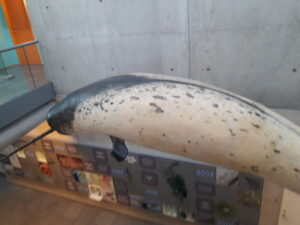The answer is no, but Moneyball might be a nudge in the right direction. I was born and live in Greenland where unicorns (also known as narwhals) roam beneath the waves. In most other cultures, unicorns are horsy creatures who roam somewhere over the rainbow. In western cultures (as defined by those who read Harry Potter) killing a unicorn is an unspeakably evil deed. It used to be different, at least for the sea creature.
Long expeditions sent north by Scandinavian kings brought back unicorn horns to make, amongst other things, drinking mugs; the theory being that unicorn horns would eliminate any poison. We have a somewhat more pragmatic approach. Whales are food, and narwhals have very delicious skin (much better than any other whale skin). Unlike pork crackling, we eat it raw. This makes narwhals a very valuable prey.

Whenever a resource is precious, there is a risk of overharvesting and politics rears its ugly head. In Greenland, restricting harvest is politically equivalent to restricting farming subsidies in the EU, or limiting gun ownership in the US. History judges the politician making the decisions, but voters employ them. History is measured decades, centuries, and millennia, election cycles are 4 years. Given the choice between being lauded by history or reelected by voters, the logical choice for a politician is continued employment and power.
In an article in our news, a department head at Greenland Institute of Natural Resources likened the east Greenland narwhal quotas to gambling with the future of narwhals in east Greenland (please note that not all narwhal populations are threatened to that extent). The current quotas come with a hefty 50% chance of extinction in a decade.
My response was “DUH, all management is a gamble” – though usually choosing much better odds. I realize that my reaction is that of a guy who spent years acquiring a hammer and who now sees nails everywhere. But still, there are a couple of interesting points to be considered here.
In this system, politicians set quotas; scientists estimate risks. By starting with a quota, scientists end up trying to answer the question: “At this quota, what are the risks we run?”
If instead, politicians answered the question: “How big a risk are we willing to take?” Then, scientists could work to translate that into a quota. Such a system is in use in some places, taking the politicians one step away from quota decisions.
An even better approach would be to start by deciding what exactly we are trying to accomplish. Asking for an optimal management strategy is like asking for the best spaghetti sauce! If there was a best sauce, each brand would have only one variety. Malcom Gladwell has a very interesting explanation of this insight.

We can ask for the maximum economic value, the maximum stable economic value (avoiding boom and bust economies), the maximum cultural value, the maximum sustainable yield (the most common option), or whichever goal we (ideally a diverse group of stakeholders) find appealing. Of course, politicians will typically choose the option that keeps them in power, regardless of the bigger issues. Hence, a 50% chance of extinction in a decade is a better bet than the near-term political fallout of a moratorium – in terms of the politician’s personal career risk.
An interesting parallel here is the climate debate. It is an exceedingly complex issue with a core concept not unlike the narwhale question. The solution to communicating it has been impressively handled. Instead of looking at what we expect to happen if we cut CO2 emissions from cars in half, and cut emissions from cows to a quarter, the whole question has been turned around and tied to a single number: 1.5 Degrees Celsius. That number has been sold as the cutoff between manageable warming and catastrophe. The rest is just math – how much CO2 (and CO2 equivalents) must be cut to get there. Even if the math converting CO2 to degrees warming is itself a bit complicated, it can be summarized in a neat graph. Of course, the political ramifications are much harder to deal with than the math.
A complicating factor is that real world outcomes are stochastic. A quota does not change the outcome directly, it changes the probabilities of various outcomes. All we can do is work to understand the probabilities and make our choices accordingly. Only one tiny snag — people are not good at understanding stochastic processes or using probabilities in decision making.
This is where Moneyball comes in. Using Brad Pitt to explain how probability theory works in real life is likely the best PR statistics can get. Central to the movie is the idea of boiling down a baseball player to a single number. The On Base Percentage (OBP) is the probability that they get on base when they are at bat (pedantically it is the best estimate of that probability). In the long run, the expected value of that probability prevails. If the average OBP of your top 3 players is higher than the OBP for the top three players of the opposing team then, on average, you win.
Fact 1, even if Brad Pitt is the main character, the real hero is the geek with the glasses (you may disagree with this, but this is my post). Fact 2, the main point of this movie is that probability theory can be useful in choosing a course of action.
Since a lot of readers of this blog are statisticians, the question we should ask ourselves is: Do we have a responsibility to educate the public about probability and statistics in a better way? That argument has been made on this blog before.
Some of us end up teaching statistics at one point or another. Perhaps we should ask ourselves if we teach the right things. A lot of statistics classes are centered on how to calculate quantities. How do you calculate a probability of some event? Maybe the better question is: “so what?”
We can calculate the likelihood of severe disease with or without a vaccine, but if the vaccine hesitant can’t use that information to decide between getting or not getting the jab, then we have failed to educate. We can calculate the risk of a particular management strategy, but if we report that risk as a probability, and few people have a good understanding of probabilities, then what is the point?
In Greenland, we have unicorns (we also have rainbows, but that is another story), we have data for managing them, and we have policymakers. A statement like “The current quotas come with a 50% chance of extinction in a decade” should be of real concern; but if it sounds like “Bla, Bla, Bla” to the people who need to hear it the most, we have an even bigger problem.





